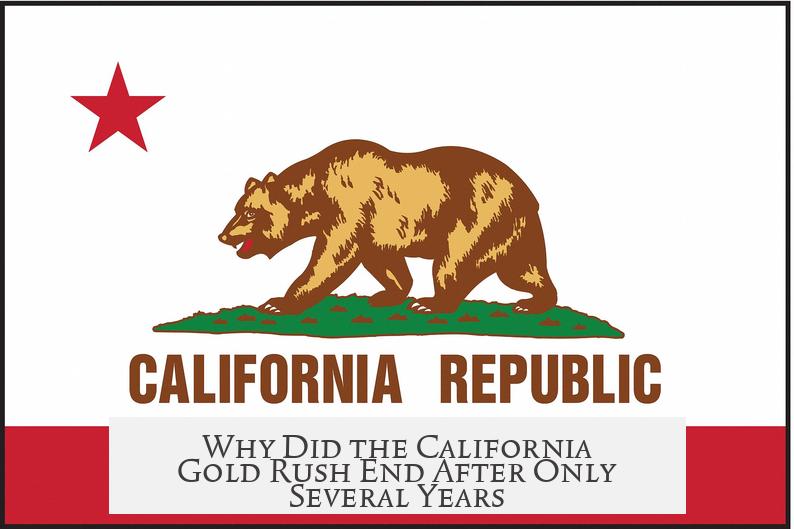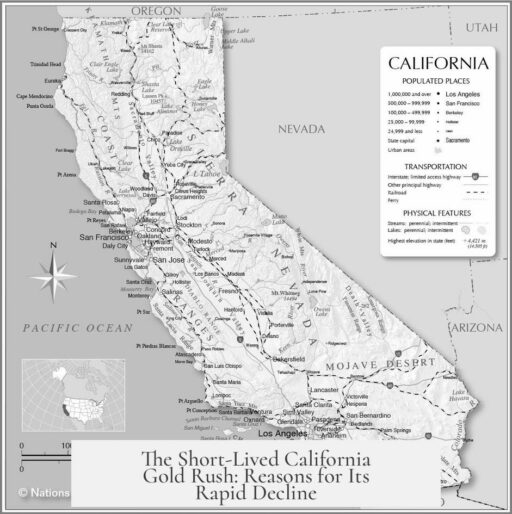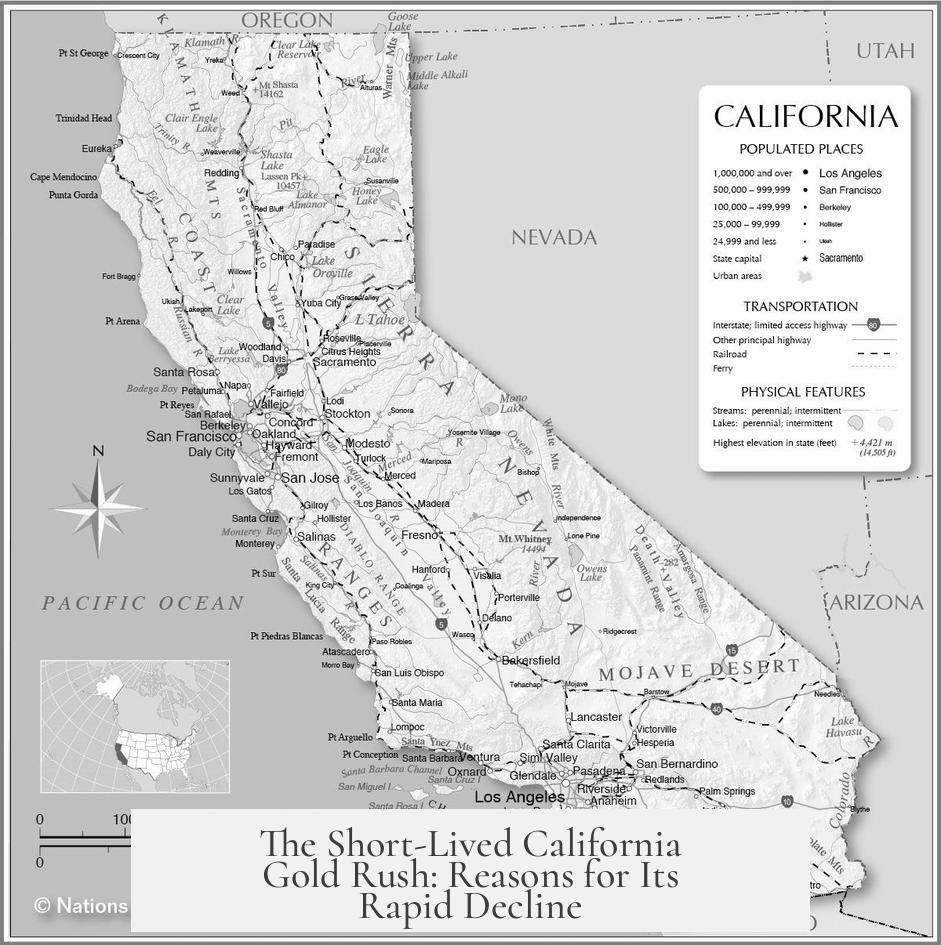The California Gold Rush ended after only several years primarily because the easily accessible surface gold deposits were quickly exhausted, making further mining less profitable and more challenging. This depletion forced miners to shift from simple surface mining to more complex underground mining, which required greater expertise, capital, and luck. As a result, many miners found it difficult to sustain profitable operations. The initial lure of “gold fever” faded as the economic returns diminished, and many shifted their focus from mining to other business ventures.
When the Gold Rush began in 1848, gold was abundant near the surface, allowing thousands of miners, known as 49ers, to extract it through simple methods. This rapid extraction led to the quick depletion of these rich, surface deposits. Within three years, miners faced declining yields, making it increasingly difficult to earn sufficient daily wages. For example, miners could only retrieve about a quarter-ounce of gold per day, earning roughly $2 daily when gold sold for about $16 an ounce. This insufficient income limited the incentive to continue mining.
Once surface gold was largely gone, miners turned to underground mining to find gold veins. However, underground mining required advanced skills, expensive equipment, and more risk. Since gold veins were rarer and harder to locate, many miners lacked the resources or knowledge to pursue this kind of mining successfully. The increased difficulty and reduced odds of finding profitable deposits discouraged many from continuing.
Additionally, the life of a miner involved significant hardship and danger. Many miners suffered serious injuries, illnesses, or death, which shortened their mining careers. For instance, some promising miners died early, reflecting the harsh conditions on mining sites.
As mining became less rewarding, the initial frenzy, often called “gold fever,” diminished. Miners and entrepreneurs gradually shifted their focus to emerging economic opportunities in California, such as banking, retail, and services supporting the growing population. Wealth generation increasingly favored businessmen who capitalized on the miners’ needs rather than the miners themselves.
- Surface gold was rapidly depleted within a few years.
- Shift to underground mining required skill, investment, and luck.
- Decreasing daily profits discouraged continued mining efforts.
- Harsh conditions caused hardship and mortality among miners.
- Economic focus shifted from mining to business and services.
- Entrepreneurs gained more lasting wealth than individual miners.
Why Did the California Gold Rush End After Only Several Years?

The California Gold Rush ended after only several years mainly because miners quickly exhausted the easy surface gold. As the gold became harder to find, mining shifted to underground methods requiring more skill and money, while declining profits and harsh conditions pushed many away. But what exactly happened there? Let’s dig into the story and vibe of the Gold Rush era, step by step.
Imagine arriving in California in 1849, hopeful and with dreams bigger than your sore boots. Tens of thousands of “49ers” flooded the landscape because gold was literally shining near the surface — easy picking, like cherries off a tree. But this bounty proved short-lived. The rush was fast, furious, and soon the gold was gone from those easy-to-reach places.
Gold in Plain Sight—But Not for Long
Gold deposits were mostly found at or just beneath the surface. This proximity meant that the early miners—often amateurs—could scrape up decent amounts quickly using simple tools.
But gold near the surface runs out fast when tens of thousands are digging daily. Within only three years, miners’ paychecks started shrinking. What they found barely covered their needs. For example, an average miner’s $2 daily wage corresponded to only about a quarter-ounce of gold per day, with gold priced around $16 an ounce at the time. Not exactly a jackpot for many.
From Shovels to Brains and Bucks—The Shift to Underground Mining
So, the simple digging game ends, and the next chapter calls for underground mining. This required specialized knowledge, equipment, and capital investment—luxuries the average 49er didn’t have. Mining veins deep inside the earth is tricky and expensive, especially when veins were rarer than surface gold.
For many, the underground mining path was a dead end because they lacked the skills or funds, and luck was less on their side.
The Harsh Reality of Life in the Diggings
Mining wasn’t just financially tough; it was physically brutal and dangerous. Many miners faced sickness, injury, and even death in those years. A sobering fact: some promising miners, like the mentioned brothers chasing deeper veins, tragically died by 1857, underscoring the perilous nature of the endeavor.
It’s no wonder many simply chose to leave or move on to other work.
Gold Fever Wanes—What Happens When the Glitter Fades?

Initially, gold fever was infectious—news, stories, and dreams propelled people westward by the thousands. But as rewards started shrinking, enthusiasm gradually dimmed. Miners realized their chances of striking it rich were slim with each passing day.
The economy in California then began to shift. Instead of gold mining, opportunities blossomed in other areas. Banking, supply stores, lodging, and entertainment for miners became more lucrative, creating a new gold rush of a different sort.
Who Really Struck Gold? Miners or Entrepreneurs?
Surprisingly, the biggest fortunes from the Gold Rush weren’t made by the miners but by entrepreneurs and bankers who cleverly served and supplied the hordes of hopefuls. They capitalized on the constant demand for goods, services, and infrastructure.
This insight turns the story on its head: The Gold Rush transformed not just the mining industry, but the entire economy and society of California.
Lessons and Reflections: Why Did the Rush End So Quickly?
What can we learn from this rapid boom-and-bust? Surface gold exhaustion shortened the easy pickings. Underground mining demanded way more from individuals than most could provide. Economic returns dwindled, making it harder and harder for miners to stay afloat.
The physical dangers and hardships discouraged continued mining, while new economic ventures offered stronger stability and wealth potential. Thus, people’s focus shifted from digging gold to digging into the new business landscape emerging around them.
Isn’t it interesting how, sometimes, chasing a dream forces you to find new paths you never imagined? The California Gold Rush ended after only a few years, but it fundamentally reshaped California’s economy, showing that sometimes, true wealth is less about the shiny gold and more about the opportunities that fill the gaps.
In Summary:
- Easy surface gold deposits vanished quickly under the frenzy.
- Mining moved underground, which was riskier and costlier.
- Daily wages dropped, discouraging small-scale miners.
- Dangers and hardships took a toll on miners’ lives.
- Gold fever declined as rewards diminished.
- Entrepreneurs made lasting fortunes by serving the mining community.
The California Gold Rush turned out to be a brief but intense phenomenon. It ended after just a few years because extracting gold grew harder and less profitable. Meanwhile, California’s economy adapted, showing us that even when a golden dream fades, new opportunities glow in the aftermath.




